IN April 1946, Jean entered the craft register and founded a radio sets construction and repair company with his childhood friend, Paul Pieretti, an accordionist and also a radio passionate. Henceforth craftmen, they rented a small workshop located at 39, rue d'Alençon in Courbevoie in Paris region and launched their business under the name Établissement Guen et Pieretty. On the official documents of the company, Paul replaced the final « i » of his patronym by the letter « y » in order to francize it. Lucienne Guen, Jean's sister-in-law, worked as the secretary. In the midst of the post-war housing crisis, Jean took up residence in the second floor of the workshop where he lived for several years.
One day in 1946, a young man brought his guitar at the Courbevoie workshop. He amplified his instrument by means of a piezo-electric cartridge placed on the sound box. He was dissatisfied with this system which generated too much treble. He then requested Jean to find a way to increase the bass response of his amplifier. Jean replied that the problem came from the piezo-electric pickup which naturally created little bass and suggested to change the pickup type.
Jean carried out his first trials with a receiver's electromagnet plugged into an amplifier that he stood close to the guitar strings. Using a wide enough magnet to cover the whole strings surrounding by a coil bobbin, Jean developed his first magnetic pickup for guitar. He originally named his creation « magnetophone » instead of « pickup ». When describing its manufacture, Jean stated : « This was mainly a mechanical issue : drawing of sheet metal, printing, drilling, tapping, glueing a magnet, making a magnetic circuit. That's called electromechanics. Regarding electricity, it's just winding a thread. [...] There was also chrome-plating, setting-up potentiometers, but it wasn't a big deal. »
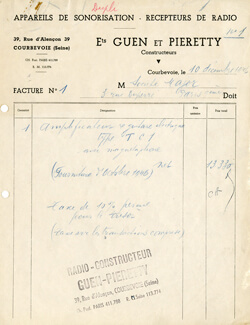
By word of mouth, other musicians willing to fit their guitars with the same type of magnetic pickup went to the workshop. « So there, I had to make a deep drawing tool and a die trimming tool. It was then that my studies at the Andresy school were useful. » In the same year, the Établissement Guen et Pieretty provided the Major wholesaler, future Major Conn, located near the Place Pigalle in Paris.
DURING the forties, drivers were obliged to leave the position lamps of their parked vehicle on as soon as dusk fell. These regulations reduced the run time of cars batteries, also called accumulators. Therefore, Jean had the idea to create a small device capable of providing ready electrical energy to batteries. « My slogan was "Start in a flash !". » Jean remembers.
This device, equipped with alligator clips allowing connection with the battery as well as a power cord, could, thanks to its compact size, be screwed inside the car. Jean first considered calling this accumulator charger « Stimul » in reference to its action consisting in stimulating the battery. « But we were accustomed to Anglo-Saxon-sounding names and I thought that "Stimer" was more appropriate for the language of that epoch. » The Stimer brand appeared in the beginning of 1947.
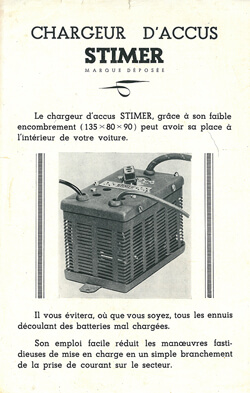
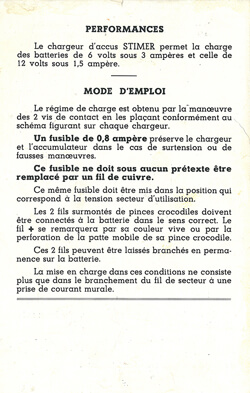
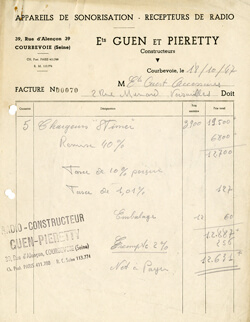
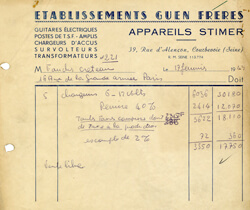
Around the year 1948, Jean hired his brother Yves, a good mechanic who worked back then as a fruit and vegetables travelling salesman. Shortly after the latter's arrival, Paul Pieretti decided to resign. The company was then renamed Établissements Guen Frères. « My brother has been very helpful because I'm just an inventor, a dreamer... But I'm not the person to make money. I'm like those that create : we create solely to create. » Jean acknowledges. Less pragmatic than his elder brother, Jean could accasionally go astray : « Major Conn ordered me ten amplifiers. I was pleased to make such a quantity, but I was yet more into echo chambers. [Edith] Piaf, when she was singing, it was sometimes ethereal. This was due to echo chambers that produced reverberation. I wanted to build some using magnetic tape. But my brother pushed me to fulfil the order, he badgered me ! His quality is that he was a good manager. »
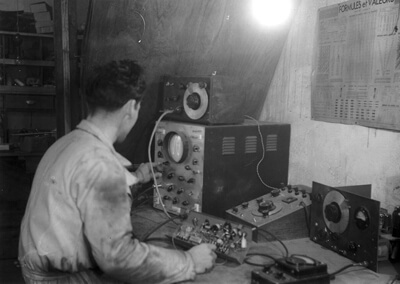
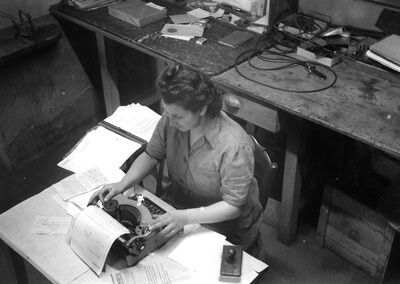
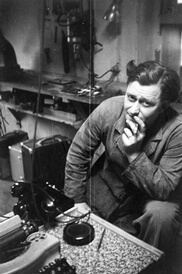
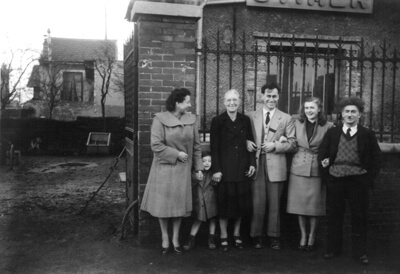
STILL in 1948, Jean made his first Stimer pickup designed to be mass-produced: the Standard 48, better known as the ST 48. Flagship product of the brand, it was adopted by many musicians
The ST 48 is a single-coil pickup housed in a chrome-plated metal housing. « The double coil avoids hum interference, Jean says. Since it complicated the manufacture and the customers didn't request it, we only made single coil pickups. » It has a power button, mounted at the end of the housing, allowing to adjust the volume of the amplifier directly from the pickup. It is attached over the sound hole, under the strings, using screws. A rubber-insulated cable enables a high impedance connection with any amplifiers. The Stimer brand is engraved on the housing.
During the same period, a range of Stimer amplifiers appeared. The first three industrial models are baptized the M 6, the P 8, later renamed the M 8, and the M 12, respectively, with a power of 6, 8 and 12 watts and weighing between 4,5 and 9 kg.
These amplifiers are fitted with loudspeakers of the French brand Véga and Visseaux tubes, french also. The Établissements Vedovelli, Rousseau & Cie, located in Suresnes, are one of the main transformers suppliers. The controls, accessible behind the case, are located on the chassis bulkhead, slightly tilted in the shape of a desk. Apart from the guitar input, they feature phono input for record players. A roll made of canvas allows to protect the speaker during transports. Four cleats are set inside the hinged lid so as to easily wind up the cables. The M 12 model includes an output for the addition of a supplementary speaker. A mixer box was subsequently created, allowing four pickups and/or microphones to be plugged into a single amplifier.
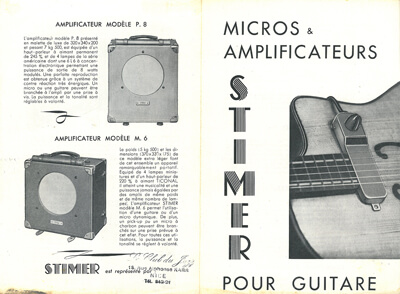
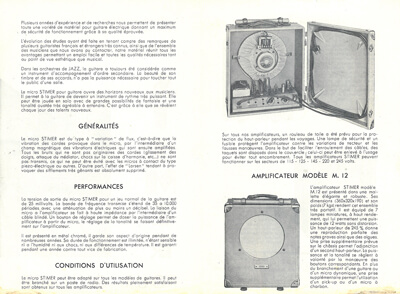
Although at that time, competition was virtually nonexistent in France - the first RV (Radio Vidéo) pickups and amplifiers made by Steve Brammer and distributed through Major-Conn store dating back to 1952/1953 - the early days were tough. Jean was facing musicians and resellers reluctance towards his novel creations. Jean remembers his first unsuccessful prospecting attempts : « I recall going to see a luthier at rue de Rome [in Paris] with my amplifier and a guitar fitted with a pickup. Fifteen minutes of demonstration in front of his friends later, he told me : "No, I'm sorry, you are going against what we are looking for". I left with the tail between the legs. Music stores didn't want it ! I recall going to see Paul Beuscher. I had an appointment. I came before Emile Prud'Homme, a well-know accordionist at that time. Mister Seiller senior [Roger Seiller was the director of music publisher Paul Beuscher] greeted me without bringing me into his office and said : "What's this ?" I replied : "This is an electric guitar". He didn't even let me try it. He asked me if it has a good future. I answered that I think so. He called as a witness to Emile Prud'Homme guitar player and asked him : "What do you think about electric guitar ?". He responded : "This is bullshit !" Once again, I left with the tail between the legs. However Paul Beuscher has then been one of my biggest customers. »
In 1950, Jean built his first solid body electric guitars, without sound box. In view of this almost unknown instrument, some showed themselves sarcastic. « We were subject to ridicule [...] People told me that it could be useful to beat the linens. » Jean says. « I sold my first guitar to a muscian who was playing at the Gaumont-Palace, on Place Clichy [in Paris]. I accompagnied him by car to his rehearshal. Once finished, we started talking about electric guitar with the conductor. He didn't know at all. It seems aberrant today but that's how things were back then ! I explained to him that it was an electric guitar without sound box. My customer showed him his guitar of which he was very proud. The conductor said : "OK, that's why I heard organ sounds while it was supposed to be guitar !" We used to produce lower tone at that time, we're seeking the organ. It was a matter of winding turns. We can modulate with electronics. » These models, not being a real success, were quickly abandoned.
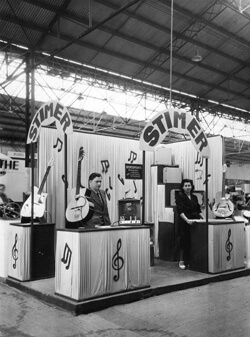
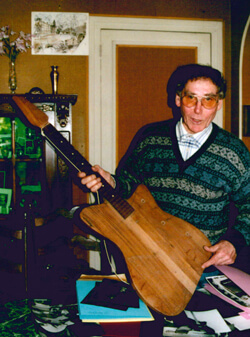
In May 1950, Jean's creations were exhibited for the first time at the Foire de Paris (« Paris Fair ») held at the Porte de Versailles exhibition centre in Paris. A few months later, in decembre 1950, the Guen brothers company participated in the first Salon International du Jazz (« International Jazz Fair» ) which took place in la Maison de la Chimie in Paris (« House of Chemistry» ).
In trade shows, many did not sense his avant-gardism. « At the Paris Fair, there were two loonies [...] There were myself, and an other one named [Georges] Jenny. Indeed this man made an instrument called the Ondioline. It was a small keyboard which could play trumpet, hunting horn and a whole bunch of other stuff. Well, that guy was perceived as a clown. I was myslef considered as a nutcase. »
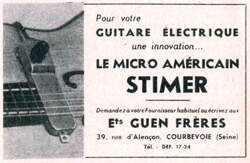
To promote the Stimer products, the Guen brothers entrusted their advertising to specialized magazines and in particular Jazz Hot and Revue de l'Accordéoniste with witch they had actively collaborated for many years.
French guitarist Django Reinhardt became the first promoter of the Stimer brand. At the end of 1950, he equipped himself with a ST 48 pickup and a M 12 amplifier. Jean rememembers this decisive encounter : « Actually, after meeting Django Reinhardt, things really started to take off. Because everybody was shunning me ! Some believed in me while others not. One day, Django and his manager went to the workshop on the rue d'Alençon in Courbevoie. They asked me to handle him. He did business with me. Then I did some advertising with Django Reinhardt. From then on, a lots of guys came to see me and things began to rise, rise... » In February 1951, Jazz Hot readers found out the first Stimer advertisement mentioning the name of Django Reinhardt. In the early 1953, the Gypsy musician posed for the French photographer Hervé Derrien in his Samois house for the purposes of a Stimer publicity which was published in the April 1953 issues of Jazz Hot and Revue de l'Accordéoniste.
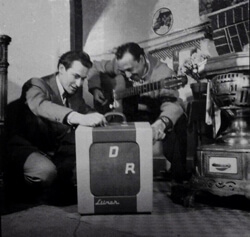
Before this collabration, Django Reinhardt, during a visit at Major music shop, had previously tried a Stimer pickup. Jean remembers an inconclusive experience : « This was before I worked with Django. Miss Deshaies [according to Jean, the Deshaies couple were the managers of the Major shop at the end of the 1940s] wanted to sell him guitar pickups. They were working together regarding advertising. There was an incredible crowd and Django was trying an electric guitar [Jean means an acoustic guitar with an added magnetic pickup], one of the first I made. Django started to play and said : "It's strange, the chanterelle [the upper string] doesn't work ?!" Then Mister Deshaies asked for a new string. "Knock, knock, knock". It didn't help. They changed the string 5-6 times, it still didn't work... During the war, it was unthinkable to make guitar or violin strings with chrome to prevent rust. They were like piano strings, pure steel. Once fingers were wet, they started to rust. So, they [the strings manufacturers] made rust-proof chrome strings. But the problem was that from a certain percentage, they were no longer magnetic. This had been a calamity for me ! I tried to do something with a dual jack so as to send a current into the coil to magnetise the string. »
Around the same period, the French guitarists Jean Bonal, Marcel Bianchi, Jean-Pierre Sasson and Henri Crolla adopted Stimer pickups and amplifiers. During his stay in Paris in the late 1952, the American guitarist Les Paul payed a visit to Jean in his workshop : « Les Paul came with Django. He and Mary Ford, his wife, bought me two pickups and one amplifier. Then, I drove them to the Bourget Airport. They were scheduled to perfom that evening at the London Palladium. It happened quickly. When I told this story to the Jazz Hot magazine, they said : "You're out of you mind ?! Les Paul and Django who came to your home, that would have made a terrific publicity !" I had not thought about that, I wasn't a typical trader. » Later, other musicians like Roger Chaput or Django's brother Joseph Reinhardt called upon the Établissements Guen Frères to provide them amplification equipment.
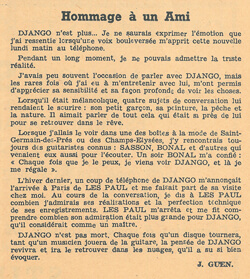
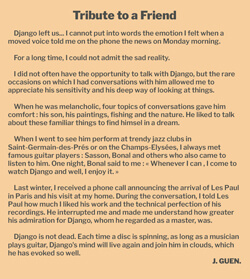
While the ST 48 fixing mean required drilling the guitar soundboard, Jean developed a pickup that is positioned on the instrument through a rod terminated with a string clamp placed between the bridge and the tailpiece. « Guys wanted no holes, so we had to find something else. A rod allowed to position the pickup at a certain lenght and it held by squeezing. And it didn't damage the guitar ! » A preliminary model, virtually unobtainable today, was issued in 1949 under the name ST 49. A final version appeared in 1951 : the S 51.
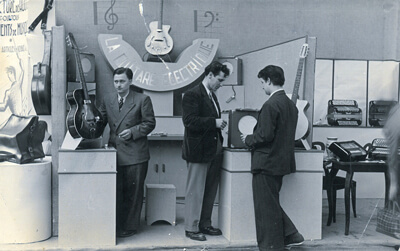
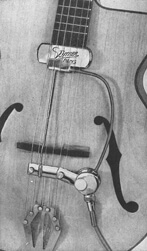
The S 51 pickup is technically similar to the ST 48 with the advantage of being attached without damaging the guitar. More complex to make, this model was more expensive than the ST 48. Thanks to its sliding rod, the pickup also enables to obtain multiple tones, lifting it at different positions . The design features a separate volume potentiometer linked to the fixing foot.
Around 1953, the company unveiled the M 10 model amplifier, with a power of 10 watts. It displayed a new yellow and brown livery, as well as a new logo. As light as the M 8 model, it has two guitar inputs with independent adjustments and a new system of rear opening without latches. M 6 and M 12 remained marketed and displayed the same appearance as their little brother. The former was fitted with an additional guitar input while the latter's power was increased to 18 watts.
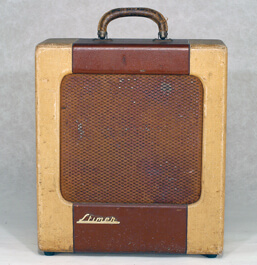
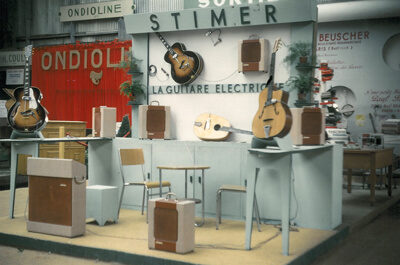
The same years, Jean finalized a new pickup for accordion with two knobs for the power and tone adjustment. It can be easily fixed to the instrument by means of four threaded rods.
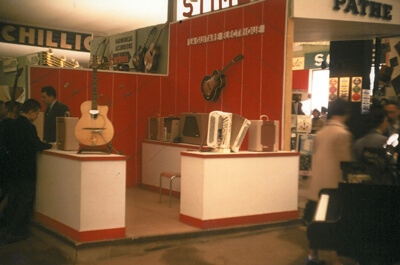
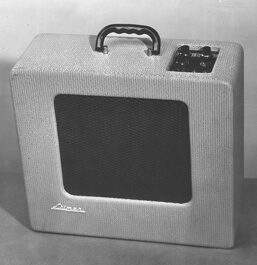
At the end of 1955, an 18-watt powered amplifier baptized Nuance, endowed with tonality changer, completed the Stimer devices series. There are two versions, with or without remote-controlled vibrato system. This model features three inputs. For the first time, the control panel has been placed on the upper side, close at hand.
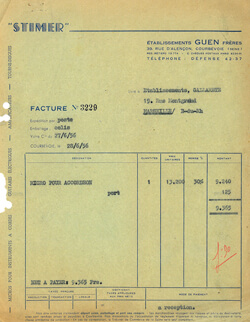
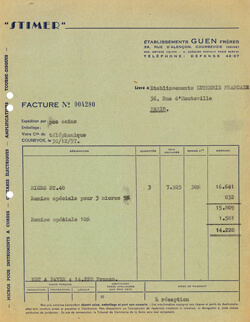
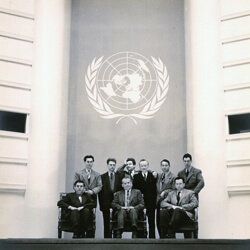
ALONGSIDE his activities in Courbevoie, Jean was recruited in September 1948, through his friend Georges Godebert mentioned earlier, as a sound technician at the Palais Chaillot in Paris where the third session of the United Nations General Assembly was held. Three years later, Jean resumed the same position at the same place within the framework of the sixth General Assembly, at the end of 1951.
In the course of these events, Jean worked on simultaneous translation system for conference allowing attendees to hear instantaneously in headphones the translation of a speech given in a foreign language.
Following this experience, Jean decided to join a simultaneous interpretation service to his activity. He then undertook the construction of a translation device, easily transportable, intended for rental during the conferences of international organizations.
This device is made of microphones for conference speakers as well as a case including four amplifiers and the control equipment. The listening is done thanks to ultra light stethoscopic headphones plugged to a strip on which switches are located, allowing delegates to select the requested language. Each interpreter, seated inside a booth, has a desk with built-in microphone. From there, they can connect to a circuit different from that of the speaker, thereby enabling the interpretation.
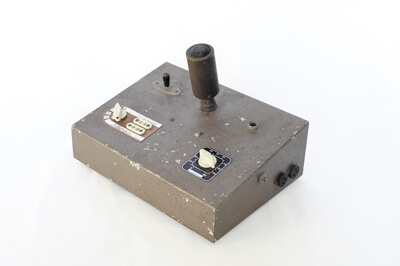
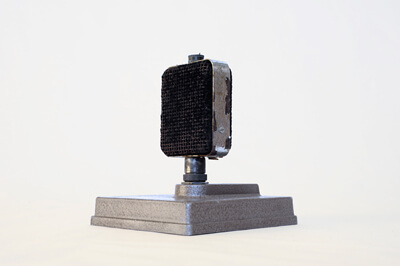
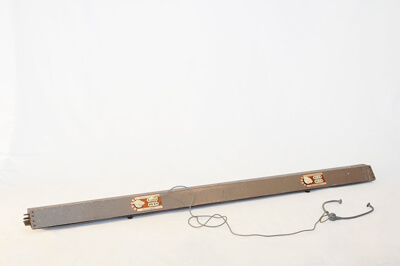
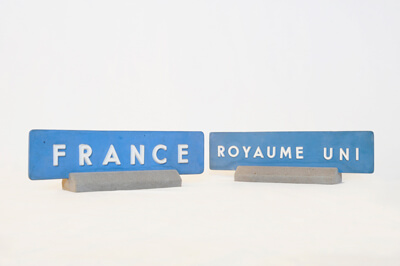
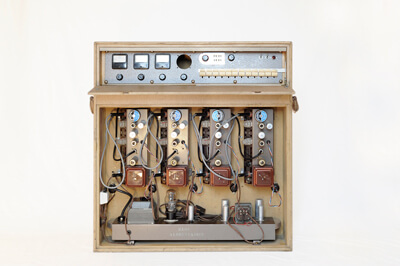
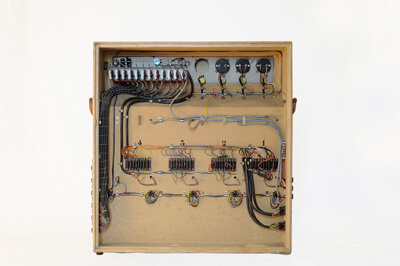
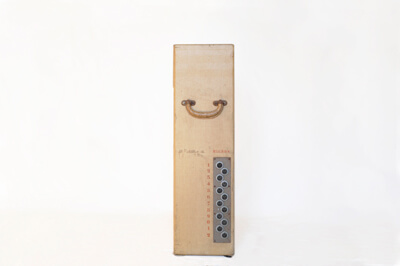
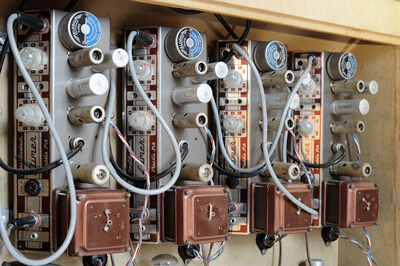
At the beginning of 1954, Jean started to canvass several international organizations in order to offer the management of the simultaneous translation system during their conferences. He choosed International Associations published by the Union of International Associations as advertising medium.
Thereafter, he had the opportunity to work for organizations such as the NATO at the Palais Chaillot in May 1954, the European Movement (International Youth Secretariat) in Cap-d'Ail during summer of 1954 or the Société du Verre Textile in Aix-les-Bains in September 1957.
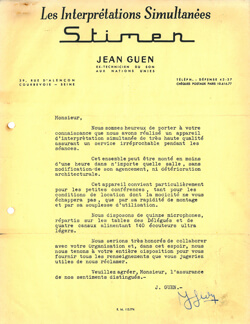
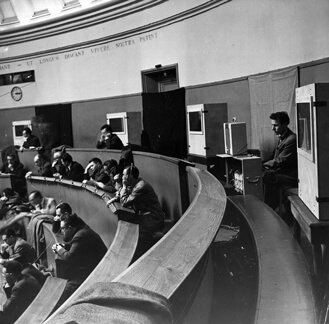
DURING 1957, Jean and Yves Guen decided to cease their collaboration. The two brothers had to share the stock of Stimer products of which they are co-owners. They came to an agreement stipulating that the amplifiers as well as the simultaneous translation device would remain Jean's property whereas Yves would retain the pickups. On first January 1958, the company was splitted and two separate accounts were opened.
This separation poses the question of the future of the Stimer brand. Jean remembers oral agreements between him and his brother at that time : « I asked him [Yves] : "What shall we do with Stimer ?" Because it was as well known as Philips ! We sold all over the world, in colonies : Indochine... We sold in England, in Germany... I suggested him to take "Stimer France" and that I take "Stimer Véritable", or vice versa. » Faced with his brothers's refusal, Jean undertook to abandon the Stimer brand : « I did not want to keep Stimer because that would place me in a position of superiority over my brother. »
Yves established his new business, the Établissements Yves Guen, at 13 avenue Montesquieu in Maison-Lafitte and undertook the production of new guitar pickups : the Django and SYG 2 models with adjustable fixing, then the S 60, composed of two pickups. He also developed several pickups designed to other instruments such as a model for violin, the Clarence model for gut-stringed and nylon-stringed instruments as well as the Électrode model for accordion.
The Yves company then moved to 11, rue de la Convention in Sartouville at the end of 1960. Yves, joined by his son Christian in 1971, kept using the Stimer brand until his death in 1986.